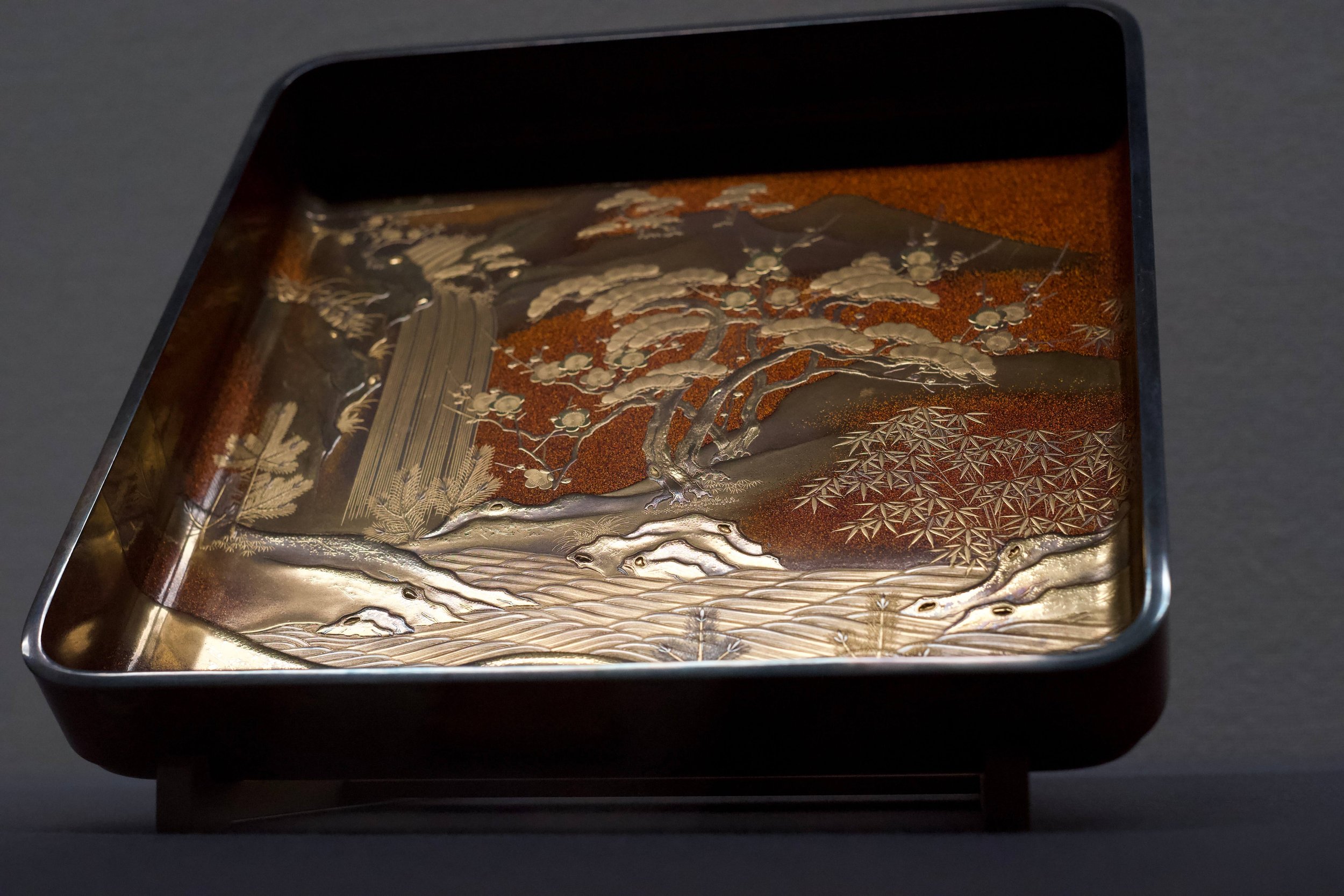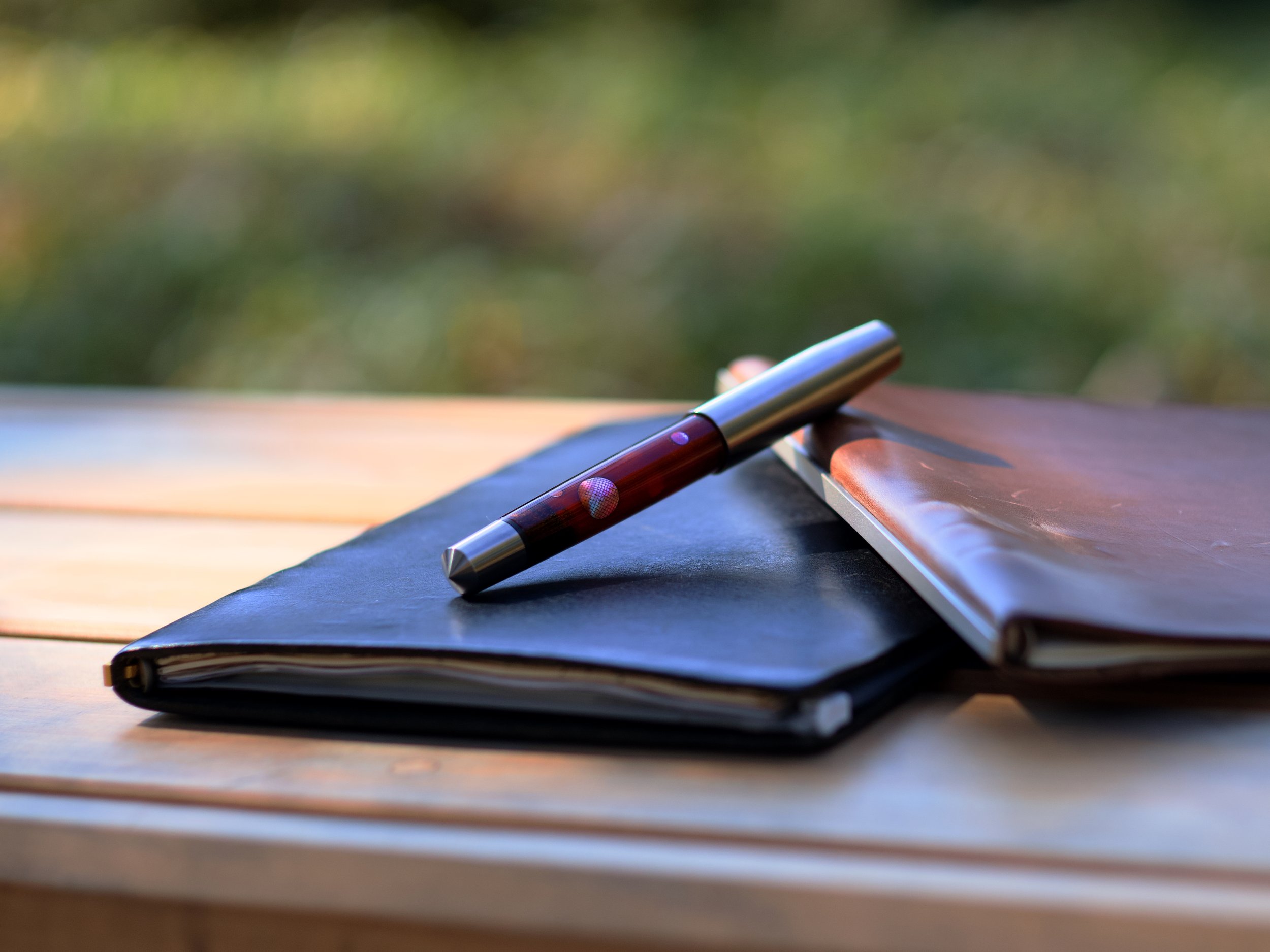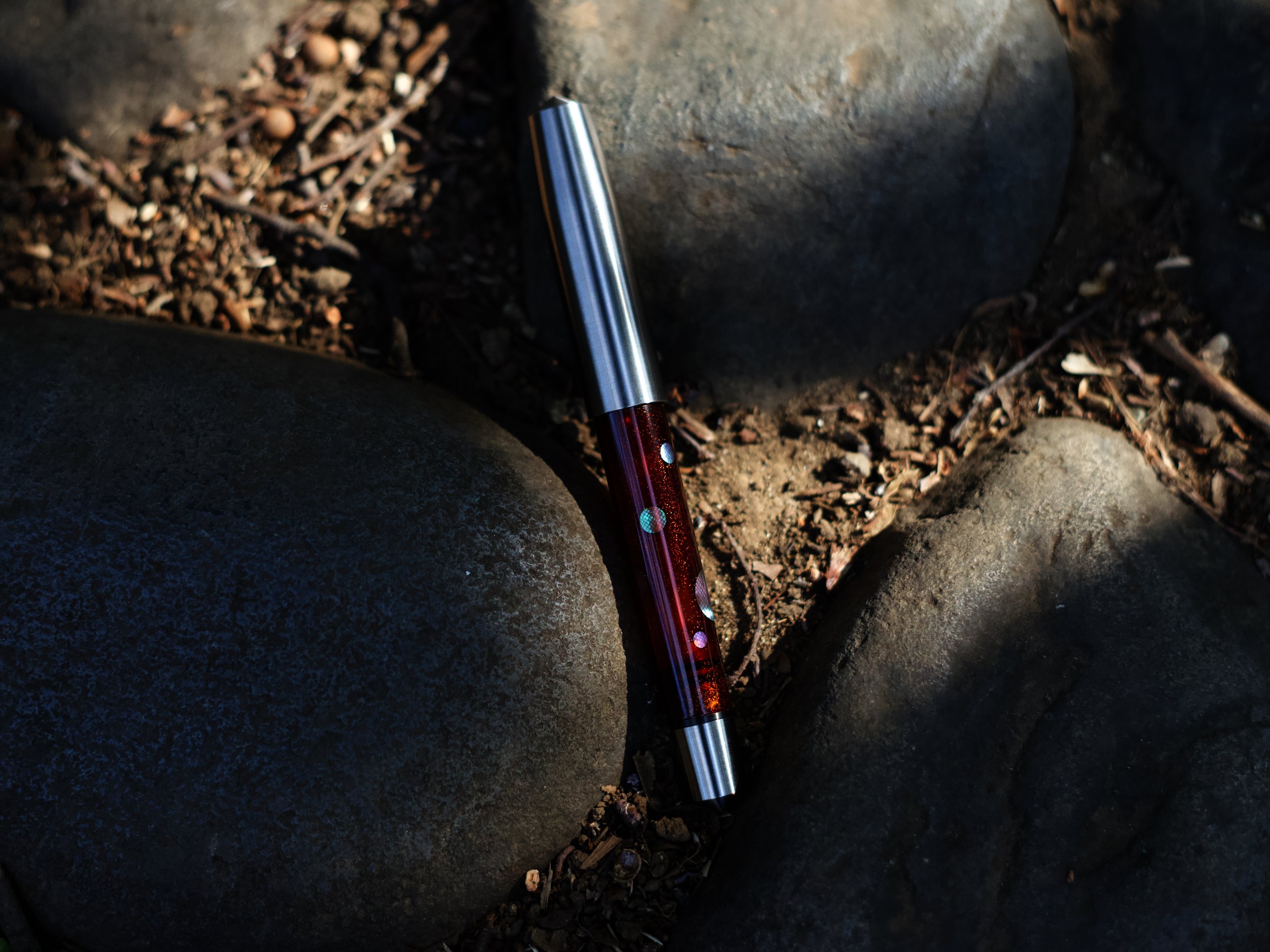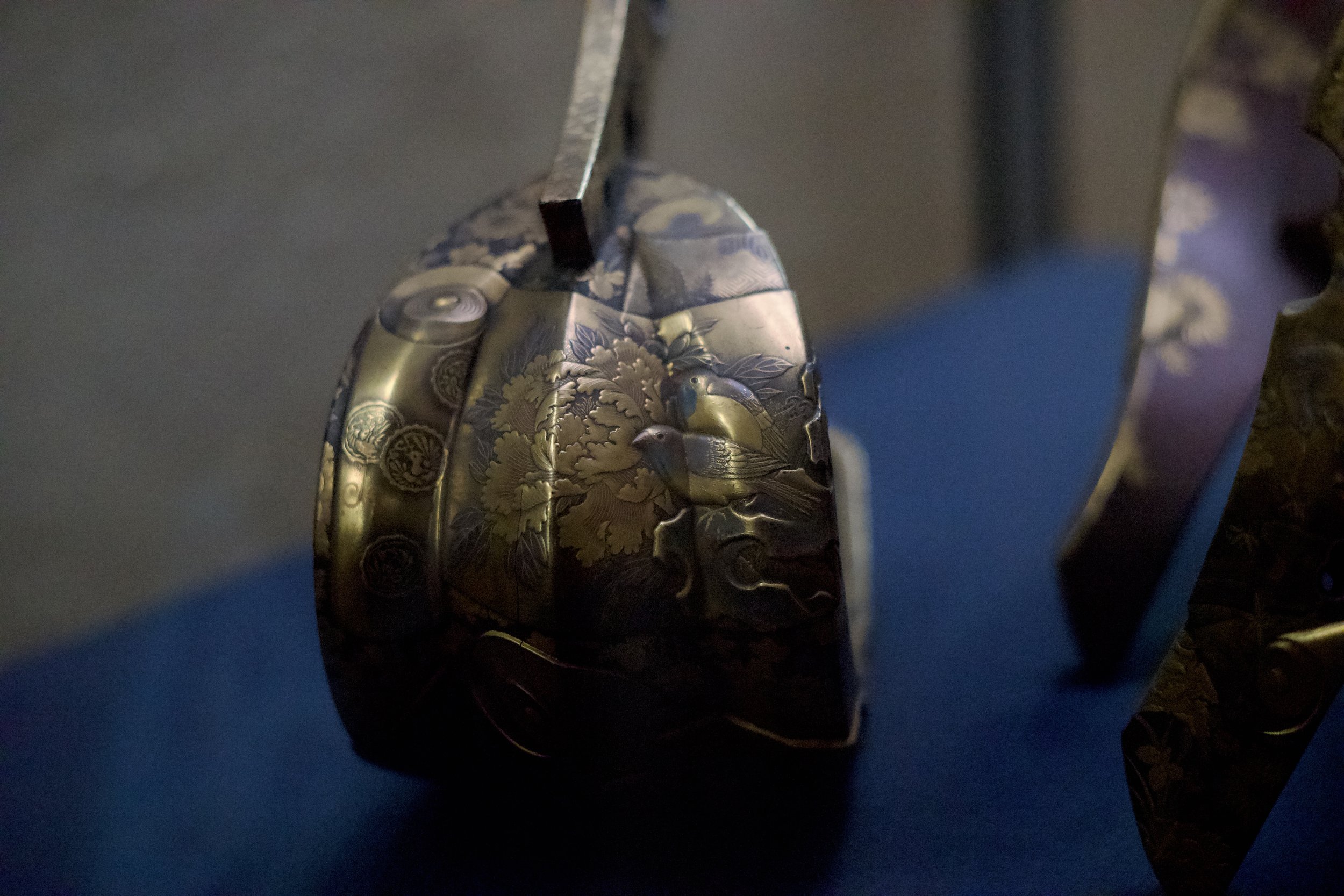An Introduction to Maki-e: The Art of Japanese Lacquer Decoration
Maki-e Inkstone Box with Phoenix by Matsuda Shokan https://www.makieshi.com/gallery/box
Gold Maki-e Comb with Bird and Flower Design, Tokyo National Museum
What is Maki-e?
Maki-e (蒔絵), which translates to “sprinkled picture” is a traditional Japanese Lacquer art form that was first developed over 1000 years ago during the Heian Period (794-1185). It involves sprinkling metal powders, commonly gold and silver, onto urushi lacquer before it has hardened, to create incredibly detailed and intricate designs.
Maki-e is considered to be one of the highest forms of Japanese lacquer art, as it showcases the skill, dedication, and sophistication of Japanese craftsmanship and has become a symbol of luxury, beauty and heritage.
Maki-e and Raden Sword Sheath with an Aoi Crest Design, Tokyo National Museum
A Brief History Of Maki-e
The term Maki-e was first recorded in the Heian Period (794-1185), although a precursor to Maki-e was recorded in the Nara Period (646-794) under the term “Makkinru”, referring to gold powder mixed with urushi to create lacquer paintings. It is thought that Togidashi Maki-e was the first technique to have been developed in the Nara to Heian Period. Metal powders were sprinkled and then covered with additional layers of urushi to increase the durability and adherence of these metal powders.
Wheels in Stream Design, National Treasure, Heian period, 11–12th Century, Tokyo National Museum (Source: Wikipedia)
Over time, other Maki-e techniques were developed during the Kamakura (1185-1333) and Muromachi Period (1336-1573), establishing the foundational techniques of all Maki-e work that followed:
Hira Maki-e (平蒔絵)
Taka Maki-e (高蒔絵)
Togidashi Maki-e (研出蒔絵)
Shishiai Togidashi Maki-e (肉合研出蒔絵)
Maki-e first made its way to Europe during the mid 16th century, where its popularity then grew in the 18th and 19th century as exports from Japan increased to other countries. However, given that Urushi and Maki-e remains an expensive and labor intensive craft, the development of modern manufacturing and plastic alternatives has led to a decline in the production of traditional Maki-e, with a decline in the number of younger artists interested in taking up this art form.
In the early 1920’s, Maki-e Master Matsuda Gonroku (who was later assigned the title of Living National Treasure) was approached to incorporate Maki-e into more contemporary objects to spread the appeal of Maki-e in overseas markets. He led the formation of the Kokkokai group within Namiki, a group of highly skilled Maki-e artists, which paved the way for the growing market of Urushi and Maki-e fountain pens in Japan and abroad.
How Is Maki-e Produced?
White Maki-e Urushi Applied with a Maki-e Brush
Maki-e can take several months to years to complete depending on the complexity and combination of techniques. Each part needs to be done sequentially and cured before the next part of the design can be continued. This process can be broken down into 6 main steps, which are repeated across different parts of the design:
Base Preparation - Preparing the substrate for Maki-e
Design Transfer - The design is transferred using urushi
Urushi Painting and Sprinkling Metal Powders
Curing of Urushi - Metal powders are adhered after curing
Consolidation of Metal Powders - Additional layers of urushi lacquer are applied
Polishing - Maki-e is completed after the final product is polished to a high gloss
Design Transfer to the Lacquerware Surface using Maki-e Urushi and Silver Powder
Base Preparation
Maki-e begins with preparation of the base object. Traditionally this would be a wooden substrate that requires a lengthy process of reinforcement to ensure durability and longevity of the finished product. The base material is covered with several layers of urushi to create a strong foundation for the designs to be transferred.
Design Transfer
The design is traced using a Maki-e brush and urushi on a sheet of transfer paper, and transferred by rubbing the design onto the surface of the base object. Gold or silver foil powder is applied to visualize the design on the surface of the object.
Urushi Painting and Sprinkling Metal Powders
The design is painted with urushi onto the surface of the object using a Maki-e brush. While the urushi is still wet, metal powders are sprinkled onto the surface using hollow tubes (Funtzusu) and soft-haired brushes (Kebo). The urushi acts as an adhesive, and the metal powders are embedded into the lacquer before it undergoes curing.
Curing of Urushi Lacquer
The sprinkled design is left to cure in a humid and warm environment. This process of painting the design and applying metal powders may be repeated several times until the entire design is completed.
Consolidation of Metal Powders
After the urushi has cured, the metal powders need to be consolidated with several thin layers of urushi to fill in the gaps between the metal powders, and increase the adhesion of the design to the surface of the object.
Polishing
After consolidation, the surface is carefully sanded with charcoal or other polishing materials, followed by final polishing to bring out the luster of the metals and create a smooth finish. Depending on the specific Maki-e technique, additional layers of raw urushi might be applied over the design, followed by more polishing to achieve the desired finish.
Urushi Lacquerware Lidded Bowl with Maki-e Crane, Mitsui Memorial Museum
Tools and Materials Used in Maki-e
Maki-e requires the use of specialized tools and materials. More specifically the wide range of different metal powders that allow for the expression of detailed designs. The main tools needed to create Maki-e are as follows:
Maki-e Urushi
Metal Powders (usually gold or silver)
Maki-e Brushes
Tubes and Brushes for Sprinkling the Metal Powder
Sanding and Polishing Materials
Maki-e Brushes, Tsutsumi Asakichi Lacquer Shop, Kyoto.
1. Maki-e Urushi
Urushi is made from the sap of the urushi tree (Toxicodendron vernicifluum). Urushi hardens through a curing process that requires specific temperature and humidity levels, resulting in a durable, glossy finish. It serves as both the base layer and adhesive for the metal powders.
Maki-e urushi is made by mixing transparent urushi with bengara pigment to create a reddish-brown lacquer, making it easier to see the design drawn on the lacquered base. White Maki-e urushi is used for working on red lacquer bases, while Nashiji Maki-e urushi is used for Togidashi Maki-e.
Left to Right: Bengara and White Maki-e Urushi
2. Metal Powders
Maki-e is characterized by the use of powdered metals, which are sprinkled onto wet lacquer to create designs. Traditional Maki-e uses primarily gold and silver powders which is reflected in the price. Modern adaptations have incorporated other metals that are more cost effective, as the prices of gold and silver have increased substantially.
Gold: The most popular choice due to its luxurious appearance and resistance to tarnishing.
Silver: Often used to complement the use of gold powder but requires additional care as it can tarnish over time.
Platinum: Rare and highly valued for its resistance to tarnishing.
Copper: Provides a reddish metallic luster, however will tarnish over time.
Tin, Brass, Aluminium: Used as more affordable substitutes for Silver and Gold. However it does not provide the same luster or appearance as genuine Gold and Silver.
Top, Left to Right: Copper, Silver, Gold Round Powder
Bottom, Left to Right: Tin, Brass, Aluminium Neo-R Powders
3. Categories of Metal Powder
The appeal of Maki-e is the ability to express detailed artwork using metal powders that have been processed into various forms. This variation in metal powders allows for a wide expression of textures and effects. Each type of powder is available in different sizes, from extra fine (size 1) to coarse (size 15 or larger). Fine powders are used for small, intricate details, while coarser powders are used for larger and more expressive designs.
Foil Powder (Keshi-fun 消粉): Created by crushing gold or silver foil into an extremely fine powder. This powder cannot be polished, and has a slightly matte and soft finish. It is better suited for display work that does not require frequent handling. This powder has higher coverage per gram, but is lower in durability compared to Round Powder.
Round Powder (Maru-fun 丸粉): Consists of finely ground metal that has a uniform, spherical shape. It is used to create soft gradients and a smooth metallic finish through careful burnishing to bring out the luster. This is commonly used for Kinstugi, and creating fine and detailed Hira Maki-e work.
Flat powder (Hirame-fun 平目粉): Round or irregular flat metal powder. This powder reflects light differently, producing a shimmering effect that adds depth and texture to designs. It is commonly used for larger areas to enhance the visual impact.
Pear-skin Powder (Nashiji-fun 梨地粉): Named after its resemblance to the speckled texture of pear skin. This powder is typically used to create a subtle, textured background that enhances the overall composition of the artwork.
Gold Maki-e Powders - Left to Right: Foil Powder, Round Powder, Nashiji Powder, Flat Hirame Powder
4. Brushes and Tools
Maki-e Brushes: Long, thin brushes commonly made of animal hair to apply maki-e urushi with precision.
Hake Brushes: Flat brushes used to apply thin, even layers of urushi.
Kebo Brushes: Soft-tipped brushes used to apply and distribute fine metal powders over the wet urushi.
Funzutsu: A hollow tube with different mesh filters used to sprinkle metallic powders evenly across the surface.
Maki-e and Hake Brushes
Kebo Brushes - Soft Haired Brushes used to Apply Metal Powders
Funzutsu - Bamboo and Aluminium powder tubes
5. Sanding and Polishing Materials
Once the design is complete, the metal powders need to be consolidated onto the surface with one or more layers of urushi. The design then needs to be burnished and polished in order to reveal the finished artwork.
Charcoal: Different grades of charcoal have been used to sand the surface of the design. Difficult to use for beginners but can produce a more even finish.
Sandpaper: Easier for larger surfaces but challenging to use for small precision work.
Crystal Whetstone: A modern alternative to using charcoal. Can be cut to size for precision work and provides an even grit-size for sanding and polishing the design.
Polishing Powders: Fine polishing powders are mixed with a small amount of oil and polished by hand to bring out the final shine.
Charcoal, Sanding Paper, Crystal Whetsone, Kikumol Polishing Paste, Migagiko Polishing Powder
Major Techniques Used in Maki-e
Maki-e involves the use of four major techniques. They can be used individually or in combination to create different effects.
1. Hira Maki-e 平蒔絵 (Flat Maki-e)
Hira Maki-e forms the foundation of Maki-e techniques. The process involves painting the design onto the surface and sprinkling the metal powders before the urushi has cured. The design is then polished to bring out the shine. The finished design is slightly raised above the surface of the lacquered body.
Hira Maki-e Flower on a Lidded Bowl - Mitsui Memorial Museum
2. Togidashi Maki-e 研出蒔絵 (Burnished Maki-e)
After sprinkling the metal powders, additional layers of urushi are applied over the design to embed the metal powders in the lacquered surface. Once cured, the surface is sanded and polished to reveal the design embedded within the lacquer. Unlike Hira Maki-e, Togidashi Maki-e results in a smooth finish as the design is sanded flat. This technique is also used to create the background of more complex designs that incorporate several Maki-e techniques.
Togidashi Maki-e Waves on a Maki-e Drawer- Tokyo National Museum
3. Taka Maki-e 高蒔絵 (Raised Maki-e)
Taka Maki-e is used to create three-dimensional designs on the surface of the lacquer. There are different ways to achieve this, including using metal, charcoal, or clay powder to build up the raised design. This is repeated several times until it reaches the desired height, and the process of Hira Maki-e is then carried out on the final layer of the design.
Box with Taka Maki-e Chrysanthemum with Raden - Tokyo National Museum
4. Shishiai Togidashi Maki-e 肉合研出蒔絵 (Raised and Burnished Maki-e)
Shishiai Togidashi Maki-e is considered the most advanced form of Maki-e. It involves combining Taka Maki-e and Togidashi Maki-e to create a more dramatic three-dimensional design that requires careful sanding and polishing to achieve an even finish across the entire surface. This technique is used to create more depth and contrast within a design and is often used in combination with the other Maki-e techniques.
Shishiai Togidashi Maki-e Box Landscape with Sakura, Maple, Pine trees and Mountains by Matsuda Shokan https://www.makieshi.com/column-uet/UBZQy-8D
19th-20th Century Maki-e Tray with Landscape with Pine Trees, Plum Blossoms, and Waterfall by Zohiko (Nishimura Hikobei), Mitsui Memorial Museum
Three Dimensional Details on the Rocks and Waves. 19th-20th Century Maki-e Tray with Landscape with Pine Trees, Plum Blossoms, and Waterfall by Zohiko (Nishimura Hikobei), Mitsui Memorial Museum
Maki-e Combines Fine Art and Function
Maki-e continues to captivate collectors and enthusiasts worldwide for several reasons. It represents exceptional craftsmanship as each piece of work requires great skill and patience to complete. The skill required to execute excellent Maki-e designs is the result of years of training and practice, with artisans often undergoing at least 10 years of apprenticeship before they are considered well versed in the craft.
Maki-e holds great historical and cultural significance in Japan, being traditionally applied to items like writing and inkstone boxes, inro cases, and tea ceremony items. Maki-e lacquerware was meant to be used and appreciated on a daily basis both at home and during special occasions like the Japanese tea ceremony.
Maki-e Inkstone Box Used For Calligraphy, Tokyo National Museum
Over the last 100 years, Maki-e has expanded to more contemporary uses, most notably its use to decorate luxury goods like fountain pens and watches, as well as its use in modern art. Given the handmade nature of Maki-e, no two pieces are identical even if it is based on the same design, making it a truly one-of-a-kind work of art. The use of precious metals like gold and silver adds to the value of the art, and cannot be replicated with other types of metals. Good quality urushi lacquer is extremely durable, and if well cared for Maki-e work can last for generations and are often passed down as heirloom items.
Due to the complex and labour intensive process of creating Maki-e works, the number of artisans have been steadily decreasing over the years as it is challenging to find younger artists who are interested in learning the craft. Methods like screen-printing have also been adopted to simplify the process of Maki-e as a means to make prices more affordable, however there is nothing that can replace the charm and uniqueness of a fully handmade piece of art.
Whether you are an enthusiast, a collector, or simply someone who appreciates beauty, understanding Maki-e helps you realize the immense value and skill that go into creating these masterpieces. Owning a piece of Maki-e is not just acquiring an object, it’s embracing a piece of history, culture, and artistic excellence.
Learn More About Our Urushi Collections:
Maki-e Workshop in Tokyo
松田祥幹 蒔絵・金継ぎ教室:
松田正観先生は、三代続く蒔絵師の家系に生まれ、東京を拠点に蒔絵作家兼講師として活 動しています。海外からのお客様向けに、2時間の平蒔絵体験ワークショップ(英語)を定期的に開催しています。また、本格的な蒔絵レッスンも開催しています。詳しくは、教室のサイトやインスタグラムページから松田先生にお問い合わせいただけます。
ウェブサイト:https://www.makieshi.com/
インスタグラム:https://www.instagram.com/makie_school_ginza/
Matsuda Shokan is a third-generation Maki-e artist and instructor based in Tokyo. He regularly holds two-hour Hira Maki-e workshops (in English) for overseas visitors, and also holds full-scale Maki-e lessons. For more information, you can contact Matsuda Shokan on his website or Instagram page.
Website: https://www.makieshi.com/
Instagram: https://www.instagram.com/makie_school_ginza/
Learn More:
Additional Resources:
Matsuda, Gonroku. The Book of Urushi: Japanese Lacquerware from a Master. Japan Publishing Industry Foundation for Culture, 2019. https://www.amazon.com/Book-Urushi-Japanese-Lacquerware-Master/dp/4866580607
Gonroku Matsuda and Maki-E Artists’ Group https://www.pilot.co.jp/100th/en/story/kokkoukai.html
Where to Purchase Maki-e Tools and Materials:






























